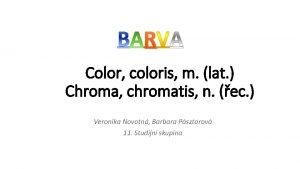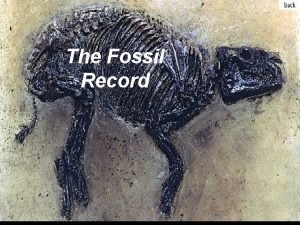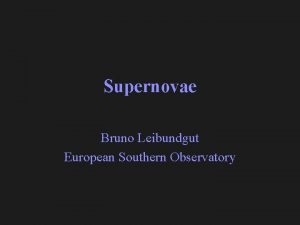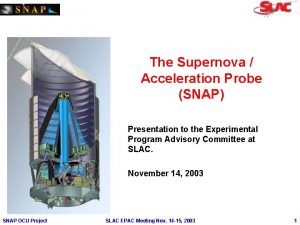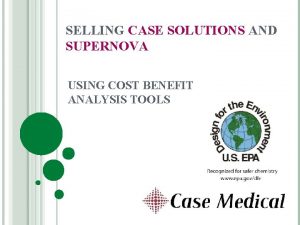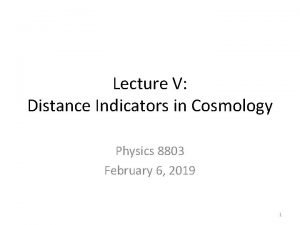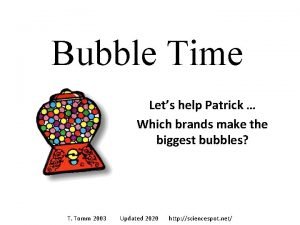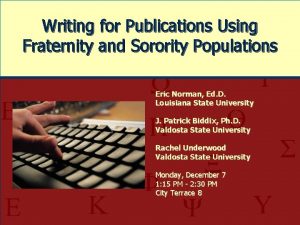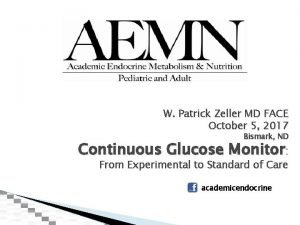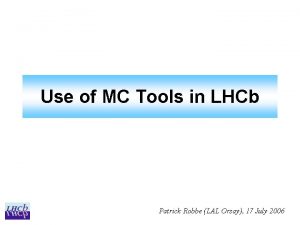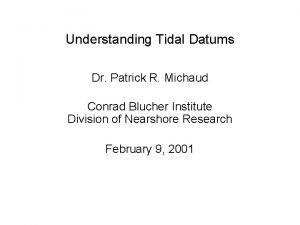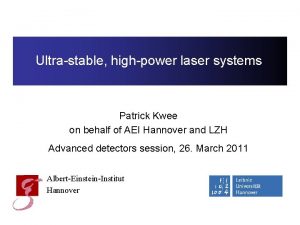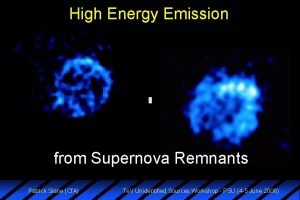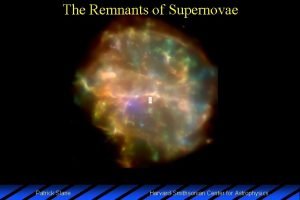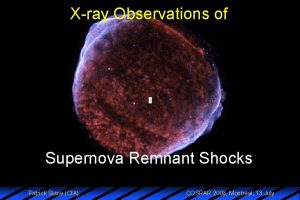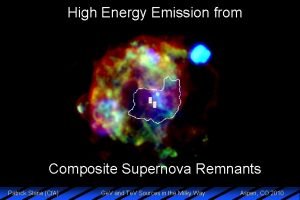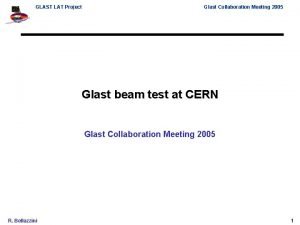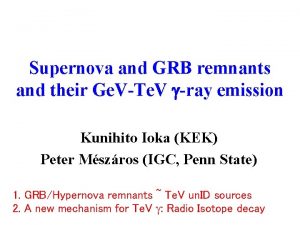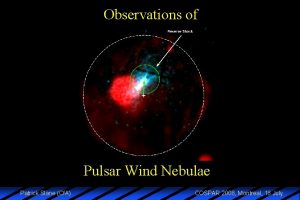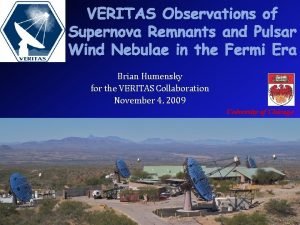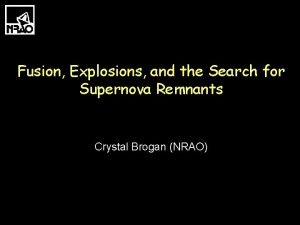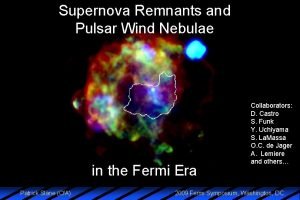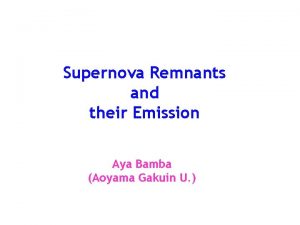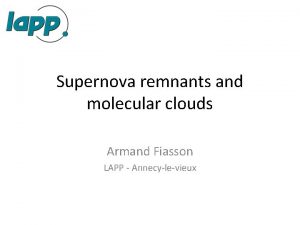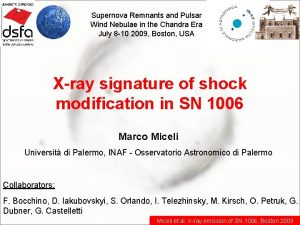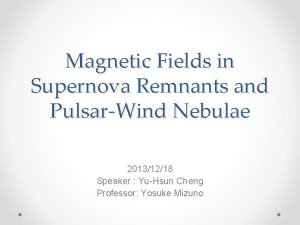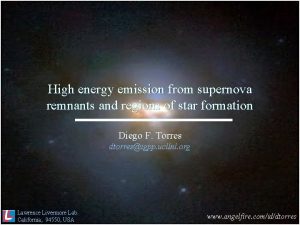Supernova Remnants and GLAST Patrick Slane Cf A
























- Slides: 24

Supernova Remnants and GLAST Patrick Slane (Cf. A) GLAST Workshop (Cambridge, MA, 6/21/07)

SNRs: The (very) Basic Structure Reverse Shocked Ejecta Shocked ISM Forward Shock � ISM Unshocked Ejecta Pulsar Termination Shock PWN Pulsar Wind PWN Shock • Pulsar Wind - sweeps up ejecta; shock decelerates flow, accelerates particles; PWN forms • Supernova Remnant - sweeps up ISM; reverse shock heats ejecta; ultimately compresses PWN; particles accelerated at forward shock generate Alfven waves; other particles scatter from waves and receive additional acceleration Patrick Slane (Cf. A) GLAST Workshop (Cambridge, MA, 6/21/07)

SNRs: The (very) Basic Structure • Pulsar Wind - sweeps up ejecta; shock decelerates flow, accelerates particles; PWN forms • Supernova Remnant - sweeps up ISM; reverse shock heats ejecta; ultimately compresses PWN; particles accelerated at forward shock generate Alfven waves; other particles scatter from waves and receive additional acceleration Patrick Slane (Cf. A) GLAST Workshop (Cambridge, MA, 6/21/07)

r v Shocks in SNRs • Expanding blast wave moves supersonically through CSM/ISM; creates shock - mass, momentum, and energy conservation across shock give (with =5/3) shock X-ray emitting temperatures Ellison et al. 2007 • Shock velocity gives temperature of gas - can get from X-rays (modulo NEI effects) • If cosmic-ray pressure is present the temperature will be lower than this - radius of forward shock affected as well Patrick Slane (Cf. A) =. 63 =0 GLAST Workshop (Cambridge, MA, 6/21/07)

r v Shocks in SNRs • Expanding blast wave moves supersonically through CSM/ISM; creates shock - mass, momentum, and energy conservation across shock give (with =5/3) shock • Shock velocity gives temperature of gas - can get from X-rays (modulo NEI effects) • If cosmic-ray pressure is present the temperature will be lower than this - radius of forward shock affected as well Patrick Slane (Cf. A) Ellison et al. 2007 GLAST Workshop (Cambridge, MA, 6/21/07)

-ray Emission from SNRs t=500 y, =36% B=15 m G 1 cm -1 -1 0. 1 cm -1 . 01 cm 15 G 60 G 3 G • Neutral pion decay - ions accelerated by shock collide w/ ambient o protons, producing pions in process: - flux proportional to ambient density; SNR-cloud interactions particularly likely sites • Inverse-Compton emission - energetic electrons upscatter ambient photons to -ray energies - CMB, plus local emission from dust and starlight, provide seed photons 3 G G Ellison et al. 2007 Patrick Slane (Cf. A) • High B-field can flatten IC spectrum; low B-field can o reduce E maxfor spectrum - difficult to differentiate cases; GLAST observations crucial to combine with other ’s and dynamics GLAST Workshop (Cambridge, MA, 6/21/07)

Broadband Emission from SNRs Note that typical emission in GLAST band is faint! Ellison, Slane, & Gaensler (2001) • synchrotron emission dominates spectrum from radio to x-rays - shock acceleration of electrons 13 (and protons) to > 10 e. V Emax set by age or energy losses - observed as spectral turnover Patrick Slane (Cf. A) • inverse-Compton scattering probes same electron population; need selfconsistent model w/ synchrotron • pion production depends on density - GLAST/Te. V observations required GLAST Workshop (Cambridge, MA, 6/21/07)

-rays from G 347. 3 -0. 5 (RX J 1713. 7 -3946) ROSAT PSPC Slane et al. 2001 Slane et al. 1999 • X-ray observations reveal a nonthermal spectrum everywhere in G 347. 3 -0. 5 - evidence for cosmic-ray acceleration - based on X-ray synchrotron emission, infer electron energies of ~50 Te. V Patrick Slane (Cf. A) GLAST Workshop (Cambridge, MA, 6/21/07)

-rays from G 347. 3 -0. 5 (RX J 1713. 7 -3946) ROSAT PSPC HESS Slane et al. 1999 • X-ray observations reveal a nonthermal spectrum everywhere in G 347. 3 -0. 5 - evidence for cosmic-ray acceleration - based on X-ray synchrotron emission, infer electron energies of ~50 Te. V Patrick Slane (Cf. A) Aharonian et al. 2006 • This SNR is detected directly in Te. V gamma-rays, by HESS - -ray morphology very similar to x-rays; suggests I-C emission o - spectrum seems to suggest -decay WHAT IS EMISSION MECHANISM? GLAST Workshop (Cambridge, MA, 6/21/07)

Modeling the Emission • Joint analysis of radio, X-ray, and -ray data allow us to investigate the broad band spectrum - data can be accommodated by synch. emission in radio/X-ray and pion decay with some IC) in -ray - however, two-zone model for electrons fits -rays as well, without pion-decay component Moraitis & Mastichiadis 2007 • Pion model requires dense ambient material - but, implied densities appear in conflict with thermal X-ray upper limits • Origin of emission NOT YET CLEAR Patrick Slane (Cf. A) GLAST Workshop (Cambridge, MA, 6/21/07)

Modeling the Emission • Joint analysis of radio, X-ray, and -ray data allow us to investigate the broad band spectrum - data can be accommodated by synch. emission in radio/X-ray and pion decay with some IC) in -ray - however, two-zone model for electrons fits -rays as well, without pion-decay component Moraitis & Mastichiadis 2007 1 d 1 m 1 y • Pion model requires dense ambient material - but, implied densities appear in conflict with thermal X-ray upper limits • Origin of emission NOT YET CLEAR - NEED GLAST Patrick Slane (Cf. A) GLAST Workshop (Cambridge, MA, 6/21/07)

Aside: Evidence for CR Ion Acceleration Ellison et al. 2007 Tycho Forward Shock (nonthermal electrons) Warren et al. 2005 • Efficient particle acceleration in SNRs affects dynamics of shock - for given age, FS is closer to CD and RS with efficient CR production • This is observed in Tycho’s SNR - “direct” evidence of CR ion acceleration Patrick Slane (Cf. A) GLAST Workshop (Cambridge, MA, 6/21/07)

Aside: Evidence for CR Ion Acceleration Ellison et al. 2007 Tycho Reverse Shock (ejecta - here Fe-K) Warren et al. 2005 • Efficient particle acceleration in SNRs affects dynamics of shock - for given age, FS is closer to CD and RS with efficient CR production • This is observed in Tycho’s SNR - “direct” evidence of CR ion acceleration Patrick Slane (Cf. A) GLAST Workshop (Cambridge, MA, 6/21/07)

Aside: Evidence for CR Ion Acceleration Ellison et al. 2007 Tycho Contact Discontinuity Warren et al. 2005 • Efficient particle acceleration in SNRs affects dynamics of shock - for given age, FS is closer to CD and RS with efficient CR production • This is observed in Tycho’s SNR - “direct” evidence of CR ion acceleration Patrick Slane (Cf. A) Warren et al. 2005 GLAST Workshop (Cambridge, MA, 6/21/07)

EGRET Results on SNRs/PWNe • SNRs are natural candidates for the production of -rays - pulsars in SNRs are young and probably active; pulsars form a known class of -ray sources - shock acceleration of particles yields -rays through a variety of processes - interactions with molecular clouds enhance emission • Establishing a direct association between SNRs and -ray sources is tricky - SNRs are large, as are EGRET error circles - SNRs distributed like other potential -ray populations Need GLAST resolution + multi- Patrick Slane (Cf. A) GLAST Workshop (Cambridge, MA, 6/21/07)

EGRET Results on SNRs/PWNe • SNRs are natural candidates for the production of -rays - pulsars in SNRs are young and probably active; pulsars form a known class of -ray sources - shock acceleration of particles yields -rays through a variety of processes - interactions with molecular clouds enhance emission At present, there is no unambiguous evidence for EGRET emission from SNR shocks Patrick Slane (Cf. A) • Establishing a direct association between SNRs and -ray sources is tricky - SNRs are large, as are EGRET error circles - SNRs distributed like other potential -ray populations Need GLAST resolution + multi- GLAST Workshop (Cambridge, MA, 6/21/07)

EGRET Results on SNRs/PWNe • SNRs are natural candidates for the production of -rays - pulsars in SNRs are young and probably active; pulsars form a known class of -ray sources - shock acceleration of particles yields -rays through a variety of processes - interactions with molecular clouds enhance emission • Establishing a direct association between SNRs and -ray sources is tricky - SNRs are large, as are EGRET error circles - SNRs distributed like other potential -ray populations Need GLAST resolution + multi- Patrick Slane (Cf. A) GLAST Workshop (Cambridge, MA, 6/21/07)

GLAST Sensitivity for SNRs o • The expected flux for an SNR is W 28, W 44, Cyg, CTA 1, Monocerus, IC 443… where is a slow function of age (Drury et al. 1994) - this leads to fluxes near sensitivity limit of EGRET, but only for large n • Efficient acceleration can result in higher values for I-C -rays - SNRs should be detectable w/ GLAST for sufficiently high density; favor SNRs in dense environments or highly efficient acceleration - expect good sensitivity to SNR-cloud 1 yr sensitivity for high latitude point source interaction sites (e. g. W 44, W 28, IC 443) Patrick Slane (Cf. A) GLAST Workshop (Cambridge, MA, 6/21/07)

Contributions from PWNe • Unshocked wind from pulsar expected to have = 10 6 - X-ray synchrotron emission requires > 10 9 - acceleration at wind termination shock • GLAST will provide sensitivity to measure max • X-ray/radio observations of EGRET sources have revealed a handful of PWNe (e. g. Roberts et al. 2006) - -ray emission appears to show variability on timescales of months; constraints on synchrotron age (and thus B)? GLAST survey mode ideal for investigating this Patrick Slane (Cf. A) GLAST Workshop (Cambridge, MA, 6/21/07)

G 119. 5+10. 2 (CTA 1) Pineault et al. 1993 Patrick Slane (Cf. A) GLAST Workshop (Cambridge, MA, 6/21/07)

G 119. 5+10. 2 (CTA 1) Slane et al. 1997 Patrick Slane (Cf. A) GLAST Workshop (Cambridge, MA, 6/21/07)

2 EG J 0008+7307: An Association with CTA 1? • CTA 1 contains a faint x-ray source J 000702+7302. 9 at center of PWN - for a Crab-like pulsar spectrum, 2 EG J 0008+7307 - this extrapolates to EGRET flux + Halpern et al. 2004 Slane et al. 1997 Patrick Slane (Cf. A) Brazier et al. 1998 • Chandra observations jet structure from compact source - definitely a pulsar, though pulses not yet detected - is EGRET source associated with the pulsar? the PWN? GLAST will isolate emission GLAST Workshop (Cambridge, MA, 6/21/07)

3 EG J 1102 -6103 Slane 2001 • EGRET source initially identified with MSH 11 -62 (composite SNR) • Error circle contains young pulsar (J 1105 -6107) and SNR MSH 11 -61 A (which appears to be interacting with a molecular cloud). Which source is it? GLAST resolution will provide answer Patrick Slane (Cf. A) GLAST Workshop (Cambridge, MA, 6/21/07)

Summary • SNRs are efficient accelerators of cosmic ray electrons and ions o - expect production of -rays from and I-C processes - GLAST sensitivity can detect SNRs in dense environments and those for which particle acceleration is highly efficient - spectra can provide crucial input for differentiating between emission mechanisms • SNRs are in confused regions - GLAST resolution will provide huge improvement in identifications, and will undoubtedly provide the first clear detection of SNRs in the 100 Me. V - 100 Ge. V band - may also find many new PWNe • GLAST survey mode provides exceptional capabilities for detecting faint SNRs and for studying variability in PWNe Patrick Slane (Cf. A) GLAST Workshop (Cambridge, MA, 6/21/07)
 Glast tm
Glast tm Lagoena fusca
Lagoena fusca Penury in romeo and juliet
Penury in romeo and juliet Evidence of evolution of remnants and impressions *
Evidence of evolution of remnants and impressions * Bruno leibundgut
Bruno leibundgut Dcarm
Dcarm Supernova acceleration probe
Supernova acceleration probe Steris decontamination sinks
Steris decontamination sinks Supernova spectra
Supernova spectra Foam remnants
Foam remnants Supernova
Supernova Chilomicroni remnants
Chilomicroni remnants Supernova mentor
Supernova mentor Patrick sells hats and has added
Patrick sells hats and has added Patrick loves bubblegum and would like
Patrick loves bubblegum and would like Patrick biddix
Patrick biddix Dr zeller wheaton
Dr zeller wheaton Patrick robbe
Patrick robbe Dr patrick conrad
Dr patrick conrad Patrick nolan amway
Patrick nolan amway Patrick barrie
Patrick barrie Npro
Npro Maestra lidia san patrick
Maestra lidia san patrick Equivalent annual annuity
Equivalent annual annuity Patrick fuhrmann
Patrick fuhrmann

